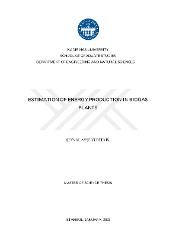| dc.description.abstract | The importance of renewable energy sources is getting more and more significant day by day. Renewable energies are required since the world's energy consumption is rising in tandem with the human population. The gas produced from wastes such as biogas, agricultural waste, and animal dung is an example of biomass energy, a renewable energy source. Machine learning is a branch of computer science that tries to improve its performance with the data it accumulates over time by simulating a human learning mechanism. This research begins with a discussion of biogas generation and investigations. The discussion then shifts to artificial intelligence, machine learning, and neural networks. In the application portion, an application of feature selection utilizing data, wastes, and biogas production from the Pales biogas plant is developed, as well as an application that forecasts biogas output using regression and an artificial neural network model. In the Python-based model, machine learning and deep learning libraries are utilized, and the data is preprocessed to make it compatible with the model. In this 22-featured model, the elements that contribute to the model, specifically biogas generation, were chosen using feature selection algorithms. The regression model and neural network model were created with the selected features as Dairy cow manure, Wheat Juice, Potato peel, Potato whole, Mixed vegie, Weak vinasse and Poultry manure. There are three distinct digesters included in the data. Three separate analyses were performed on three distinct digesters, and the findings were compared to the cumulative data. In the study, 20% of the data were set aside as test data and 80% were used for training. In terms of model performance, the data feature selection approach was effective for regression models, but negatively effect of variable reduction in neural networks. The R2 score was 52% in the neural network model trained without variable selection, and the mean of regression models trained with feature selection was 49%. | en_US |
















